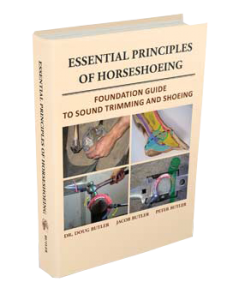Graduates Page
Butler Professional Farrier School attracts the very best students from across the United States and international countries. We’re very proud of their dedication and success and they have good reason to be proud of themselves! Here’s what graduates say about their experience at Butler Professional Farrier School…
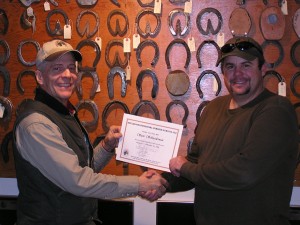
Doug Butler and Steve Schneiderman
“At the other school I attended, they’d show you how to do it, but you didn’t have much instruction. Here you had more instructions in how to do stuff, and I think it helped out a lot. I think Jacob did a good job teaching. There was more structure. I think classroom time was the best – you learn more about the diseases and lameness, and it built my knowledge base. My favorite was working with navicular horses: I got a few cases at home of navicular horses that were going pretty good, but now I feel I have a better understanding of it. I enjoyed the forging a lot. Before I came here I wanted to get better in the forge – now I can make egg bars, straight bars – make my own shoes as need be. I had goals to get better in the forge and get better with anatomy. I knew the leg anatomy, but I wanted to get better with veins, ligaments, nerves, defects in the leg, and I feel like I did it.” –Greg Franklin, FL

Rod Scott
“Mr. Butler and Jake are phenomenal teachers – they really take their time to not only get points across but make sure you’re competent when you leave the place. I look at the business more professionally. Pete is a phenomenal young man. He helped our whole farrier experience. They let you know that they really care on how you are taught and what you know.” –Rod Scott, WA
“I’ve come a long way — you’re really all so knowledgeable, and that’s really helped a lot as far as learning how to trim and balance feet, shape shoes, and forge work. I know a lot more of why I’m doing things. Learning how to balance the foot, knowing how much to take off instead of guessing – the best thing I learned is “why” and “how much.” I feel like I can tell someone now what I’m doing. Diseases and how to deal with them was good. The time in the classroom was very beneficial.” –Carl Filip, WY
“It was very organized. I love how there was homework every night and the illustrations and drawings. It just really was sequential. You’re always just learning it and relearning until it becomes a part of you and what you do. It’s a great system. It is a good balance working on horses and working in the forge. I liked working on different kinds of horses. I wanted to find a school that had a really firm foundation in the very core anatomy knowledge. –Allison Reese, NV
“It’s been a great environment for concentrating on what you want to learn. If you come to learn, you’re going to learn it. There’s ample time and ample space. You have all the opportunities you need. There’s no time wasted. You know what you’re going to do each day.” –Zac Cleveland, MT

Andrew DeVisser
“I really like the way the daily schedule is done – good ratio of class time, hands-on. It’s really inspired me to work at it and become proficient. I’m going to apprentice for 2-3 years to get a good foundation. I liked the dorm and had everything I needed. I would definitely recommend this school. It’s a good learning environment – it’s a great place to learn. It teaches you everything you need to know for fundamental knowledge. There was a lot more hands-on stuff than I thought there would be. Skills I learned – forging was a big one, modifications of shoes, basic corrective stuff that I learned while I was here.” –Andrew DeVisser, CANADA
“The instruction was very good – there was always someone to help with questions I had. Before coming here I had thought about going to another school until we found out Dr. Butler has a school. He teaches a lot; he explains a lot – he knows what he’s talking about. He tells you why you have to have a shoe on that way and doesn’t just tell you to do it. You learn the ‘why’ and get some of his experience in with it. After I go home, if I come across a case I need help with, I can call up – that’s helpful enough.” –Weston Earls, CA
“I learned my anatomy – I can describe it better to the client and learn what the vet is talking about. My speed has increased a lot – I just did a horse in 1 ½ hours – all four feet. I enjoyed the metallurgy – colors of the steel and then shaping it on the anvil. There’s a lot more to learn than just trimming a hoof – you have to make sure it’s balanced for one and it’s dressed accordingly. I had to learn how to position myself, being so tall, but I learned how to be comfortable for me and the horse. Confidence came with shoeing lots of horses.” –Kevin Gerwatoski, CANADA
“I felt the horse time was good, and the spread of horses and the different horses – it’s not like you have an Arab barn or whatever – you have mustangs, draft horses, navicular cases, laminitis, extreme founder cases so we got to see a lot. I love the fact that we’re really a small class, and it was almost like we were hand-picked to fit together. It was really a cohesive class.” –Bruce Moffitt, TX
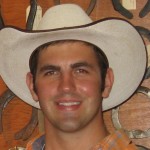
Lane Pohlsander
“Using the sequence of shoeing Doug gave us has really helped. … I gained lots of confidence, and that has to do with the number of horses that we’ve been working on because you get to see different behaviors of different horses and different sizes and breed types and foot problems. I feel like I could go and shoe a normal horse very easily.” –Lane Pohlsander, UT
“You guys are some of the best teachers I’ve ever learned from, and I’ve been going to school all my life. The teaching style is great. … My confidence grew from being able to do horses every single day. I’ve ridden horses three times in my life, and I’ve petted a horse maybe a couple of times. That’s about it. Now I’m picking out feet, trimming hoofs and leveling them, and getting some of this stuff right! … every day has been a positive experience. The facility is great; the place you are is great. But if you took the facility away, you could be out in the middle of the desert with no facility at all, and I would still say, ‘If anyone wanted to learn the farrier business, they need to come to you three.’ You know what you’re doing, and you know how to teach it.” –Duane Sapp, Georgia
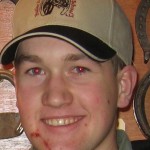
Caleb Fisher
“I liked the hands-on experience – the combination of talking about it and then doing it. Other farriers in my area recommended this school. They said Doug Butler stands for what he says he does. The experience has prepared me to think with an open mind but yet back it up with what is proven. I learned the basics and some more!” –Caleb Fisher, PA
“The first day you come here, it doesn’t matter if you’ve been shoeing for a few years or haven’t shod a horse at all, you start working with and shoeing horses. You don’t start working with dead legs. To be honest, no one is going to pay me for shoeing dead legs, so why should I work on those? The only time I worked on a dead leg was doing the dissection, and that was really helpful. I was really happy to have this kind of a broad variation in the horses – everything from little mini’s to big draft horses, horses in different stages of training, and you get lots of experience.” –Steindor (Steini) Thorisson, ICELAND
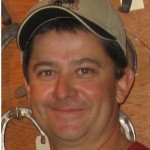
Ricky Brown
“The best part was building my confidence. I thought it was an advantage to be here away from everything – no distractions. –Ricky Brown, AUSTRALIA
Essential Principles of Horseshoeing
Discover a new interactive way to learn the principles of horseshoeing and humane horse foot care! Essential Principles of Horseshoeing is the latest book now also available in audio format from Doug Butler Enterprises that uses detailed graphs, charts and QR codes that take readers to video demonstrations, just as though you were sitting in the classroom!
Contact Us
Butler Professional Horseshoeing School
495 Table Road
Crawford, NE 69339
(800) 728-3826
jacob@dougbutler.com
Subscribe to Our Blog
Get Our Free e-Book!
If you think you want to become a farrier (or know someone who does), this book can help you make that decision. Horse owners will learn the importance of choosing a qualified farrier and how to select the “right” one.
[ Get the e-Book Now! ]
- Follow:

